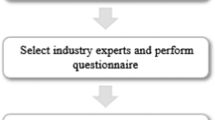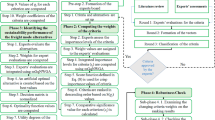Abstract
Data Envelopment Analysis (DEA) is a well-known methodology to measure relative efficiencies of transportation systems. In the real world, it is necessary to determine how to combine two separated efficiency measures in a unified structure. The conventional Data Envelopment Analysis (DEA) cannot be applied for these situations. Also, the efficiency scores may not be meaningful, especially when the number of Decision Making Units (DMUs) is insufficient. This study combines DEA and Nash bargaining game as a cooperative game theory approach to evaluate the performance of transportation systems by a large scale of measures. The proposed approach regardless of the number of units discriminates among the units more effectively. Besides, these measures may be classified in different categories and DMUs are evaluated simultaneous with different categories in the competitive environment. In this paper, we define two categories of inputs (operational and spatial) to measure performance of transportation systems. Furthermore, managers determine that each bus line in which category has better performance and in which lines is inefficient. The case study of bus lines evaluation is presented to show the abilities of the proposed approach.
Similar content being viewed by others
References
Adler, N. and Berechman, J. (2001). “Measuring airport quality from airlines’ viewpoint: An application of data envelopment analysis.” Transport Policy, Vol. 8, No. 3, pp. 171–181, DOI: 10.1016/S0967-070X(01)00011-7.
Amirteimoori, A. (2011). “An extended transportation problem: A DEA-based approach.” Central European Journal of Operations Research, Vol. 19, No. 4, pp. 513–521, DOI: 10.1007/s10100-010-0140-0.
Banker, R. D., Charnes, A., and Cooper, W. W. (1984). “Some methods for estimating technical and scale inefficiencies in data envelopment analysis.” Management Science, Vol. 30, No. 9, pp. 1078–1092, DOI: 10.1287/mnsc.30.9.1078.
Barnum, D. T, Tandon, S., Sue McNeil, P. E., and ASCE, M. (2008). “Comparing the performance of bus routes after adjusting for the environment using data envelopment analysis.” Journal of Transportation Engineering, Vol. 134, No. 2, pp. 77–85, DOI: 10.1061/(ASCE)0733-947X(2008)134:2(77).
Charnes, A., Cooper, W. W., and Rhodes, E. (1978). “Measuring the efficiency of decision-making units.” European Journal of Operational Research, Vol. 2, No. 6, pp. 429–444, DOI: 10.1016/0377-2217(78)90138-8.
Diana, T. (2010). “Can we explain airport performance? A case study of selected New York airports using a stochastic frontier model.” Journal of Air Transport Management, Vol. 16, No. 6, pp. 310–314, DOI: 10.1016/j.jairtraman.2010.03.006.
Du, J., Liang, L., Chen, Y., Cook, W. D., and Zhu, J. (2011). “A bargaining game model for measuring performance of two-stage network structures.” European Journal of Operational Research, Vol. 210, No. 2, pp. 390–397, DOI: 10.1016/j.ejor.2010.08.025.
Friedman, L. and Sinuany-Stern, Z. (1998). “Combining ranking scales and selecting variables in the DEA context: The case of industrial branches.” Computers and Operations Research, Vol. 25, No. 9, pp. 781–791, DOI: 10.1016/S0305-0548(97)00102-0.
Jitsuzumi, T. and Nakamura, A. (2010). “Causes of inefficiency in Japanese railways: Application of DEA for managers and policymakers.” Socio-Economic Planning Sciences, Vol. 44, No. 3, pp. 161–173, DOI: 10.1016/j.seps.2009.12.002.
Kevin Cullinane, K., Wang, T. F., Song, D. W., and Ji, P. (2006). “The technical efficiency of container ports: Comparing data envelopment analysis and stochastic frontier analysis.” Transportation Research Part A, Vol. 40, No. 4, pp. 354–374, DOI: 10.1016/j.tra.2005.07.003.
Kim, H.G., Choi, C. Y., Woo, J. W., Choi, Y., Kim, K., and Wu, D. D. (2011). “Efficiency of the modal shift and environmental policy on the Korean railroad.” Stochastic Environment Research and Risk Assessment, Vol. 25, No. 3, pp. 305–322, DOI: 10.1007/s00477-010-0369-0.
Lao, Y. and Liu, L. (2009). “Performance evaluation of bus lines with data envelopment analysis and geographic information systems.” Computers, Environment and Urban Systems, Vol. 33, No. 4, pp. 247–255. DOI: 10.1016/j.compenvurbsys.2009.01.005.
McMullen, B. S. and Noh, D. W. (2007). “Accounting for emissions in the measurement of transit agency efficiency: A directional distance function approach.” Transportation Research Part D, Vol. 12, No. 1, pp. 1–9. DOI: 10.1016/j.trd.2006.10.001.
Nash, J. F. (1950). “The bargaining problem.” Econometrica, Vol. 18, No. 2, pp. 155–162, DOI: 10.2307/1907266.
Yu, M. M. (2008). “Assessing the technical efficiency, service effectiveness, and technical effectiveness of the world’s railways through NDEA analysis.” Transportation Research Part A, Vol. 42, No. 10, pp. 1283–1294, DOI: 10.1016/j.tra.2008.03.014.
Yu, M. M. and Fan, C. K. (2006). “Measuring the cost effectiveness of multimode bus transit in the presence of accident risks.” Transportation Planning and Technology, Vol. 29, No. 5, pp. 383–407, DOI: 10.1080/03081060600917728.
Author information
Authors and Affiliations
Corresponding author
Rights and permissions
About this article
Cite this article
Rezaee, M.J., Izadbakhsh, H. & Yousefi, S. An improvement approach based on DEA-game theory for comparison of operational and spatial efficiencies in urban transportation systems. KSCE J Civ Eng 20, 1526–1531 (2016). https://doi.org/10.1007/s12205-015-0345-9
Received:
Revised:
Accepted:
Published:
Issue Date:
DOI: https://doi.org/10.1007/s12205-015-0345-9




